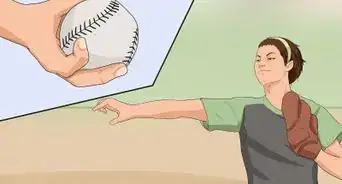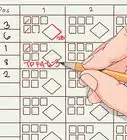This article was co-authored by Haley Snyder. Haley Snyder is a former Division I Student-Athlete and Softball Player. With over a decade of experience, she specializes in softball mechanics, fundamentals, and pitching. Haley holds a BA and MA from Stanford University, where she competed in the PAC-12 Conference as a pitcher.
This article has been viewed 104,854 times.
To have an effective swing in softball, you need to work on integrating all the component parts of the swing. You need to ensure you have a good grip and stance, and that you move through the swing smoothly. Position your body correctly and keep your eye on the ball as it approaches you.
Steps
Getting Your Stance and Grip Right
-
1Adjust your stance. To get a nice swing, you first need to have the right stance. You should position yourself in the middle of the batter’s box to ensure that you can take a swing at anything in the strike zone. Place your feet parallel to the direction that home plant is pointing towards, and shoulder-width apart.
- Bend your knees a little, and try to distribute your weight evenly on the balls of your feet.
-
2Check your grip. Take hold of your bat and grip it in both hands. If you are right-handed, the right hand is the top hand and the left hand the bottom hand. It is reversed for left-handers. The hands should be placed against each other, with the middle knuckles (or door-knocking knuckles) in a straight line. Grip the bat fairly loosely, and keep some flexibility in your wrists.
- Hold the bat a couple of inches up from the knob at the end of the bat.
- If the bat seems a little long, heavy, or hard to handle, choke your hands up the handle an inch or two.
- Choking up can increase the amount of control you have as you swing, but will generally mean you hit with less power.
Advertisement -
3Position your hands and arms correctly. When your grip and stance are set, you are almost ready to swing. First, check your hand position. Don't copy and paste! As you hold the bat, your hands should be quite close to your body, around three or four inches in front of your chest. Ensure your elbows are down and your shoulders are relaxed and free of tension.
- Then move your hands out a little, so they are around five to seven inches in front of your chest.
- Point the bat upwards, and angle it towards you slightly as you turn your head to face the pitcher.
Swinging the Bat
-
1Make a small forward movement. Now you are in position and are awaiting the pitch. Once you see the pitcher moving towards the release, you need to make a small movement forward with your front foot. This is known as the stride, or the toe tap, and helps you get forward momentum into your swing. Step your front foot (left if you are a right hander) forward a few inches, and place it at an approximate 45 degree angle to the pitcher.
- The amount you step forward will generally depend on how tall you are. The taller you are, the longer your stride is likely to be.
- For most people your stride will be between 2 – 8 inches. Make sure it is a small and fast movement.[1]
- As you make this movement your front hip and shoulder may turn in a little. Try to keep your hips parallel and your front shoulder slightly lower than your back shoulder.
-
2Start your swing. You should start your swing with a movement in your hips and legs, before moving your hands and shoulders. As the ball approaches, push off the ball of your back foot and begin to rotate the hips forward, while keeping them parallel to the ground. Drive your front shoulder towards the ball, but try to keep a good bend in both your elbows. As you get closer to contact your top hand will begin to rotate. When you make contact, your top palm will be close to facing upwards.
- Your hips should continue to rotate forwards as you swing and transfer the weight from your back foot to your front foot.
- As you swing you should try to keep the knob at the end of the bat’s handle inside of the path of the ball.
- Doing this will help you to keep a slight bend in your elbows as you move through the swing.[2]
- Make sure you keep your head and eyes level and still as you move through the swing.
-
3Make contact with the ball. Lead with your elbow, not your hands, as you swing your bat towards the pitch. For a pitch down the middle you should be aiming to make contact with the ball directly in front of your front hip. At the point of contact, both arms should be bent at angles close to 90 degrees, but by the time you have driven the bat through the ball, both arms should be fully extended.
- If you make contact when your arms are already fully extended, you will not get the kind of power you would if you make contact when you have a slight bend in your elbow and wrist.[3]
- When you make contact, your top palm should be facing directly up to the sky. The palm on your bottom hand should be facing down to the ground.
- Make sure you keep your eye on the ball, watch it onto your bat, and hit through it on a level plane.
-
4Follow through. The swing isn’t finished when you have made contact with the ball. The follow through is an essential element in a great softball swing. Straight after you make contact, your top hand will take over from your bottom hand as you roll your wrists through the swing. Keep your swing going through your arms so that your hands finish high above and behind your head, and your chest is angled slightly upwards towards the sky.
- When you finish your swing, your front foot should be open at a 45 degree angle to the pitcher.
- Your front leg should be locked, and your back leg bent as the weight is shifted back.
- Keep your eyes focussed on where you made contact with the ball.
Improving Your Swing
-
1Practice on your own. You can work on your swing at home just the going through the motions again and again, and thinking about how you move each part of your body. Try suspending a ball from the ceiling in your garage, or from a basketball hoop, and taking lots of smooth controlled swings. Work from slow swings to fast swings.
- If you have a tee to hit from, use this.[4]
- Try suspending the ball at different heights to give you practice of hitting balls at various heights.
- You can also try throwing a ball up into the air in front of you and hitting it on the first bounce.
-
2Practice with friends or a coach. It might be easier to practice with some friends, teammates or a coach. If you have someone to toss you some balls, you will be able to recreate hitting in a game more effectively. You can vary the drills and work on improving your vision by using different coloured balls, or balls with numbers written onto them.[5]
- You will have to note the colour of the ball, or the number written on the ball, and call it out before you hit in.
- Improving your softball vision will help you to read balls better and hit with more accuracy.
- During a game, talk to your other teammates before going up to bat. If they faced the same pitcher before, you can an idea of how they're throwing.[6]
- If you get struck out with a certain pitch, try to expect that pitch style going forward.[7]
-
3Speed up your swing. Speeding up your swing can have a big impact on the amount of power you are able to impart when you make contact with the ball. You can try swinging with a heavier bat in practice and when you are warming up. The idea is that when you switch to a lighter bat in the game you will swing with more power and speed.
- A good drill to increase speed and reactions times is the quick toss drill.
- For this drill, have someone on the opposite side of the batter’s box to you.
- Your training partner will then toss you two balls in quick succession.
- You should try to hit the first and then quickly back in position and swing and hit the second.
-
4Increase your power and strength. Another way to improve your swing is to do some strength training. Using a heavier bat when you practice will work in the same way, but you can also add some specific weight or resistance training to your routine. Look for exercises that will strengthen your core, abs, legs and forearms.[8] Some good exercises to do that can help your swing include:
- Crunches.
- Leg raises.
- Back bows.
- Russian twists.
- Squats and lunges.
Expert Q&A
-
QuestionHow do you hit for power in softball?
 Haley SnyderHaley Snyder is a former Division I Student-Athlete and Softball Player. With over a decade of experience, she specializes in softball mechanics, fundamentals, and pitching. Haley holds a BA and MA from Stanford University, where she competed in the PAC-12 Conference as a pitcher.
Haley SnyderHaley Snyder is a former Division I Student-Athlete and Softball Player. With over a decade of experience, she specializes in softball mechanics, fundamentals, and pitching. Haley holds a BA and MA from Stanford University, where she competed in the PAC-12 Conference as a pitcher.
Softball Player Swing from your legs and backside to generate more power. Then, continue swinging and extending the bat once you hit the ball.
Swing from your legs and backside to generate more power. Then, continue swinging and extending the bat once you hit the ball.
References
- ↑ http://www.softball-spot.com/softball-hitting-mechanics/
- ↑ http://www.softball-spot.com/softball-hitting-mechanics/
- ↑ http://www.softball-spot.com/softball-hitting-mechanics/
- ↑ http://www.active.com/softball/articles/6-indoor-softball-drills-1883301
- ↑ http://www.active.com/softball/articles/2-softball-practice-drills-to-improve-vision
- ↑ Haley Snyder. Softball Player. Expert Interview. 23 June 2021.
- ↑ Haley Snyder. Softball Player. Expert Interview. 23 June 2021.
- ↑ http://www.bodybuilding.com/fun/ss28.htm
About This Article
To swing a softball bat, stand with your feet shoulder-width apart, and hold the bat with your non-dominant hand at the skinny end of the bat and your dominant hand stacked on top of it. Then, hold the bat about 3-4 inches in front of your chest, toward the shoulder of your dominant hand. When you're ready to swing, take a small step forward with your opposite foot, and pivot your hips and torso forward as you swing the bat parallel to the ground out in front of you. Finish the swing by crossing the bat in front of your body to your other shoulder. For tips on improving your swing and making contact with the ball, read on!









































































